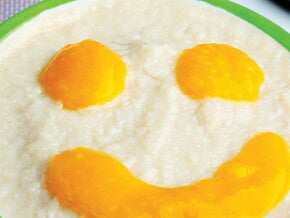
Congratulations on reaching this exciting milestone and have fun feeding your baby his first foods. Starting solid foods is a new and exciting step in your baby’s eating development, but it often comes with many questions. You may be wondering what foods are recommended as the first solid food, how to know when your baby is ready, and how to really get started. The guidelines that follow will help you through this next phase of his big move to solid foods.
Big nutrition for small tummies
After six months of age, babies need additional foods along with breastmilk to support their growth and development. As their stomachs are still small, those foods need to contain a lot of nutrition. Iron is one important nutrient babies will need at this age so the first foods introduced should be rich in iron. Meat is a great source of iron and recommended as one of your child's first foods.
Fortified infant cereals also provide big nutrition for small tummies. They are designed to provide essential nutrients in a small serving, perfect for a small tummy that can’t hold much food at one time. Infant cereals are easy to digest and fortified with iron which makes them another good option for first tastes of solid food. Start with a thinner consistency, and move to a thicker texture as your baby gets used to eating from a spoon. This lets you keep pace with his developing eating skills. Introducing new textures and flavours at the appropriate time is an important part of establishing lifelong healthy eating habits.
How do I know he’s ready?
Young babies have yet to develop the skills needed to move solid foods around in their mouth and successfully swallow, by 6 months of age, your baby will have developed the motor skills needed to sit up during feeding, draw food off a spoon, and turn his head away when full.
Look for these milestones:
- Sits with no help because he’s gained control over his upper body.
- Turns his head to the left or right.
- Moves his tongue backward and forward in a smooth rhythm when you put a small spoon to his lips. This allows him to draw food in and swallow it. It may take a few days to get used to eating from a spoon, but he will learn quickly!
GOOD TO KNOW
It is always smart to speak with your paediatrician around your baby’s 6-month visit about how to start solid foods.
Spooning up good nutrition
Young babies are rapidly growing and have specific nutritional requirements. Fortified infant cereals provide a blend of B vitamins, Zinc, Calcium, Iron and Vitamin E, all key for his rapid growth. The nutrition of Iron-rich cereal can be an important part of baby’s diet until the age of two.
Setting the stage for his first taste
Here are a few tips for getting your baby ready to take that first spoonful of baby food.
- Breastfeed so she won’t be fussy or too hungry.
- Take your time. Choose a time of day you do not have to rush.
- Choose the appropriate spoon. Use a small baby-sized spoon that’s coated to protect your baby’s tender gums.
- Sit her in an upright infant seat or high chair, making sure head is in an upright position, not tilted back.
- Let her explore. Place a dab of puree or cereal on her high chair tray so he can "finger paint" with it and become familiar with its texture. Let her explore the feel and smell of the food. This is both fun and messy! Keep your sense of humour and keep the camera handy for pictures.
- First Bite! Sit facing your baby and hold the half-spoonful of food about 12 inches from her face. Get her attention and put the spoon up to her mouth. For the first bite, try putting a dab of food on her lip. If she's agreeable to that first taste, put the next bite into her mouth when she opens it. Feed your baby as slowly or as rapidly as she wants and always look for her fullness cues. It’s all about the experience!
- Try, try again. Don’t be surprised if your baby’s first taste pops right back out. It’s a natural reflex. If your baby seems unhappy about this experience, give it up for now and try again later.
GOOD TO KNOW
Breastmilk is still your baby’s main source of nutrition. This is a time of introducing new flavours and textures to your baby, a time of exploration.
Tips for introducing iron fortified infant cereals
- Start with infant rice or oatmeal cereal. Wait several days, and if there are no reactions, try infant barley cereal. Offering only single-grain cereals at first lets you pinpoint any possible food sensitivities or reactions—such as a rash, diarrhoea or vomiting—your baby may have to a new food.
- Prepared cereal should never be fed from a bottle—only from a spoon—unless directed by your paediatrician.
- When first starting cereal, mixing with breastmilk is recommended. Move to a thicker consistency once you feel your baby is mastering the thin texture.
- Prepare only as much as you think he will eat. Don’t save cereal that’s been prepared, as it can grow bacteria very easily.
TOP TIP
Waiting three days before introducing another food lets you watch for any signs of any intolerance or sensitivity—such as rash, diarrhoea, runny nose or vomiting. If you suspect a reaction, stop feeding your baby the new food and speak to your paediatrician.
A day in your 6 to 7 month old’s diet
This sample day was created by registered dieticians to help meet the nutrition goals for your 6 to 7 month old baby. Your child may eat more or less, so always follow his hunger and fullness cues.
Morning feeding
Breastmilk (cow’s milk should not be offered to babies younger than 1 year old)
Breakfast
2 tablespoons pureed fruit, such as peaches or pears
2 tablespoons dry iron-fortified infant cereal mixed with breastmilk
Mid-morning snack
Breastmilk
Lunch
1/4 cup or 4 tablespoons pureed vegetables, such as carrots
4 tablespoons pureed meat
Breastmilk
Afternoon snack
Breastmilk
Dinner
2 tablespoons dry iron-fortified cereal mixed with breastmilk
2 tablespoons pureed fruit
Breastmilk
Evening feeding
Breastmilk

Foods to wait on
Giving your baby more adult foods, such as sweetened beverages, chips or cookies, may seem like a treat for your little one, but nutritionally these don’t offer much. Babies need nutrient-dense foods that deliver important nutrients relative to the amount of calories suitable for their age.
Hold up on the sugar and salt
Some babies are being introduced to salty snacks, chips and soda as young as 7 to 8 months old. These foods are inappropriate for such young children and run the risk of filling them up before they can eat more nutritious foods. This also establishes poor eating habits at a very young age that may become harder to change as time goes on.
Do not offer sweetened beverages
Sweetened drinks should not be part of the infant's diet. And, because of their relatively high natural sugar content, some nutrition and health experts suggest that fruit juices should not be introduced during the first year. If you choose to offer juice, you may start after six months by offering juice from a cup to introduce new flavours. Never offer juice in a bottle. Start with 1 to 2 oz. per day, and limit juice to no more than 120 ml a day. Only give your child 100% juice, not juice drinks or other blended juice-like beverages, which contain added sweeteners.
Waiting on cow’s milk
The World Health Organisation recommends that infants be fed breastmilk during the first year of life. This is to ensure a good supply important nutrients in your baby’s diet. Cow's milk is not an appropriate beverage for your baby before 1 year of age.
CONSULT YOUR DOCTOR
Talk with your paediatrician to see which milk option is right for your child once he’s reached his 1 year old birthday.
Hold off on the honey
Honey can contain botulinum spores and cause serious health problems. Even in small amounts, honey can be dangerous for a baby younger than 12 months.
Prevent choking
Your baby will start out with thinly pureed foods, work up to thicker textures, then move to tender pieces of food. You might think he’s ready to handle more, but do not give your baby foods that are known choking hazards until at least age four or older.
Some foods that may be choking hazards:
- Raisins and whole grapes.
- Popcorn, nuts and seeds.
- Hot dogs, chunks of meat or poultry.
- Spoonfuls of peanut butter.
- Hard, raw or chunky fruits and vegetables such as whole peas, raw carrots, bell peppers, apples, unripe peaches, pears or plums.
- Gum, chewy or hard candy.


















